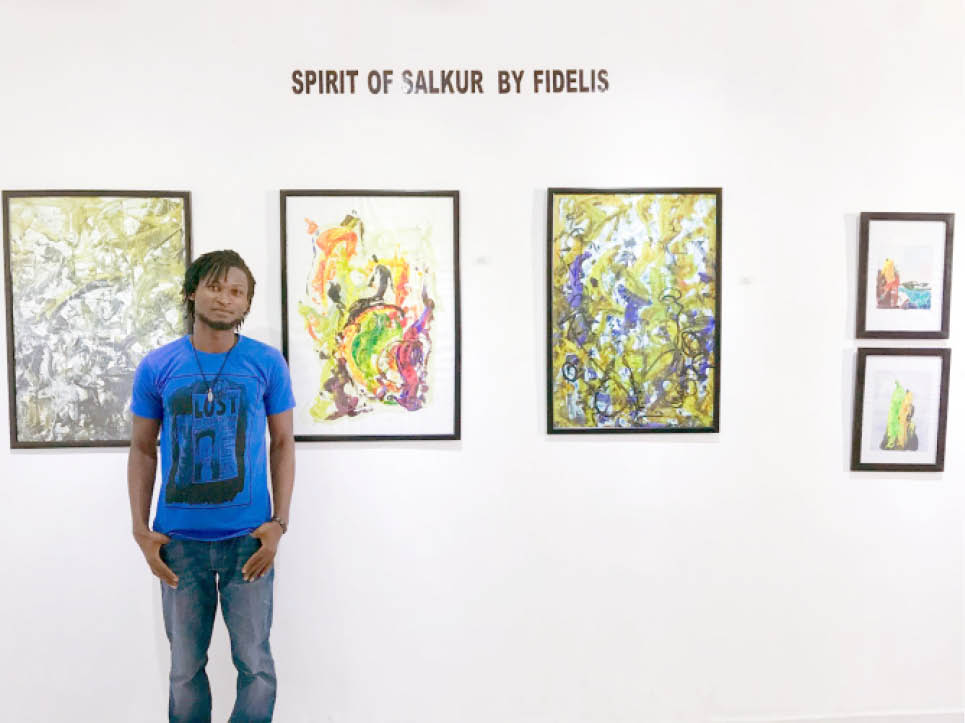Why my paintings explore metaphysical world – Fidelis John
Fidelis Joseph is one of the artists selected for Rele Arts Foundation’s ongoing fourth Young Contemporaries Exhibition. The exhibition, which began on January 13 this year, will run through March. Joseph, who is from Adamawa State, is showcasing his abstract paintings with the theme ‘Spirit of Salkur’, as a way of interrogating the metaphysical realm. […]

Joseph poses before his paintings
Fidelis Joseph is one of the artists selected for Rele Arts Foundation’s ongoing fourth Young Contemporaries Exhibition. The exhibition, which began on January 13 this year, will run through March. Joseph, who is from Adamawa State, is showcasing his abstract paintings with the theme ‘Spirit of Salkur’, as a way of interrogating the metaphysical realm. Here, he talks about his work and more. Excerpts:
You are one of the artists selected by the Rele Arts Foundation for the fourth edition of the Young Contemporaries Exhibition at the Rele Gallery. How did this happen?
I came across Adenrele in a certain meeting, during which she invited me to her gallery. We had a discussion on art and she told me if I was interested in participating in the Young Contemporaries Exhibition, I should give my contact details. When it was time for the selection, they requested for my portfolio. I later received a male that I have been selected.
Presently, you are exhibiting some paintings under the theme, ‘The Spirit of Salkur’. What informed this theme?
Salkur are extra-ordinary people in Adamawa State. They are found among the Margi people of Madagali Local Government Area. But we also have the Margi in Borno. We call them Salkur because they have supernatural strength and abilities which have to do with a spiritual connection with animals. It’s an initiation which takes place when they are very young. They grow up with a spiritual attachment to animals.
So, as an artist, since my focus is on the metaphysical, realities that are not visible to the eyes, I tend to look at the spirit of man and animal and how they interact. My body of work is inspired by the metaphysical. I also feel that since the Salkur are important to the history of the Margi and they are going extinct, I should say something about them, especially because I am from that part of the country.
What was the process like and what has posed a major challenge so far?
The Margi people, between the boundaries of Adamawa and Borno are internally displaced right now and insurgency threatens their culture. Some are in other parts of the country trying to make ends meet. I feel emotional about this because some of them may not get to go back. I was conscious of that while working on the paintings.
It’s challenging explaining my inspiration to others because people don’t easily relate to it. It’s difficult to make them see it the way I do and also put it in context. But this is something that happens where I come from.
Your paintings on this project are all abstract. What is the reason for this choice?
I didn’t know how else to depict my thoughts and imagination on this particular theme. The abstract form worked for me.
I have studied a little bit on abstract paintings and come across works that interest me, such as that of Professor Jerry Buhari. I also want people to see different things in my work, and that has been the case so far.
You studied Fine Arts from Ahmadu Bello University, Zaria. Some artists don’t go through such formal education and yet do great works. What in your opinion stands out someone who runs a Fine Arts degree program?
I think how they look at artworks is different from those who didn’t attend an art school. The criticism and experience we get from our instructors shape the way we view art. I also think that there are some rudiments you get to learn in school, except you go through an internship. I have come across artists who lack knowledge of how to prepare their surface. Some tend to be successful though. However, our training makes us more critical.
You have done some mixed media art and portraits, away from the abstract territory. Do you see yourself focusing on anything else aside abstract paintings in the future?
I don’t see myself as an artist who wants to remain in the same circle. I see myself evolving and doing more experimental works.
At what point in your life did you decide you wanted to be an artist and what was the journey like?
I decided to be an artist around 2011 when I came across Jonathan Imasidor. His encouragement and some of the things he taught me, put me in the direction that made me take it seriously. He gave me reasons to continue. But before then, I was doing portraitures at home. I wasn’t in an art school, but was seeking admission. Then a neighbour encouraged me to go for a professional course in the arts.
What project do you look forward to working on?
I look forward to working with different art foundations and also offering humanitarian services in my state.
